
In fact, several resources I looked up recommended using Sessions instead of Catalogs. I could copy sessions across disks without having to worry about Capture One not reading them correctly or back them up offsite and not have to worry about reimporting them into Capture One for rework later etc. The self-contained aspect of Sessions initially appealed to me. A Catalog in Capture One is conceptually the same as its namesake in Lightroom – a single master database tracks multiple projects and albums. Each Session has its own database which tracks changes, edits etc. A Session is a self contained mini-library with its own folder structure to store captured, selected, exported and rejected photographs.
Capture One has two ways to store and work with photographs – Sessions and Catalogs. This was the first decision I had to make. When I have to refer back to some old photographs or when I get the time, I bring over projects one at a time from Lightroom. So I now use Capture One exclusively for new projects. But this is not yet complete – my catalog in Lightroom is far too big to bring over to Capture One in so short a time. Having been thus enamored by Capture One, I started a migration of old projects from Lightroom. NEF files) to JPEGs while Capture One took 561s, almost double the time! But since I’m usually not sitting in front of the computer while exporting, I can to live with it. In a quick test I conducted, Lightroom took 293s to export 139 RAWs (Nikon, so.

The one step, admittedly critical, where Capture One is slower than Lightroom is the export of edited photographs. Responsiveness when making adjustments is better in Capture One than in Lightroom – this is especially apparent when working with layers and drawing masks. In general use, the initial import is faster (and doesn’t consume as much memory as Lightroom), jumping from one photograph to the next is quick and switching between tool-tabs is snappier than switching between the Library and Develop modules (the two I spend most time switching between) in Lightroom. Lastly, in my experience, Capture One is faster than Lightroom 6. Take a look at the comparison below, the crop on the left is from Lightroom and on the right from Capture One.

Capture One absolutely blew Lightroom out of the water in the way it handled these RAWs. Worse still, when sharpening Fujifilm RAWs, Lightroom introduces wormy artifacts rendering them unusable. Lightroom has a known problem with Fujifilm RAWs – the way it processes them makes heavily textured photographs look like they’ve been painted on. Capture One is clearer and sharper which makes the overall photograph look more pleasant, which in turn means I spend less time editing it.īesides my trusty DSLR, I own a mirrorless Fujifilm X100S. In the comparison below, on the left is a crop of the default preview from Lightroom and on the right is that from Capture One. This, in general, meant I spend a little less time making adjustments in Capture One than in Lightroom. Despite having read about this in several articles, I was pleasantly surprised and impressed. I also found the the initial rendition of photographs in Capture One to be better than Lightroom. I should note however that although some tools in Capture One behave differently than their counterparts in Lightroom, they were intuitive enough for me to pick up rather easily – a prime example of this being the Levels tool. This gives Capture One a level of customizability that just isn’t possible in Lightroom. can be freely placed within these tool-tabs.

Different tools, like exposure adjustment, color editor, histogram etc. Unlike Lightroom, Capture One doesn’t have fixed modules – instead it has so-called Tool-tabs, which are freely definable. Its UI looks great and feels crisp & polished. The first impression Capture One made upon launching it was great. Several aspects of Capture One swung my decision its way.


 0 kommentar(er)
0 kommentar(er)
